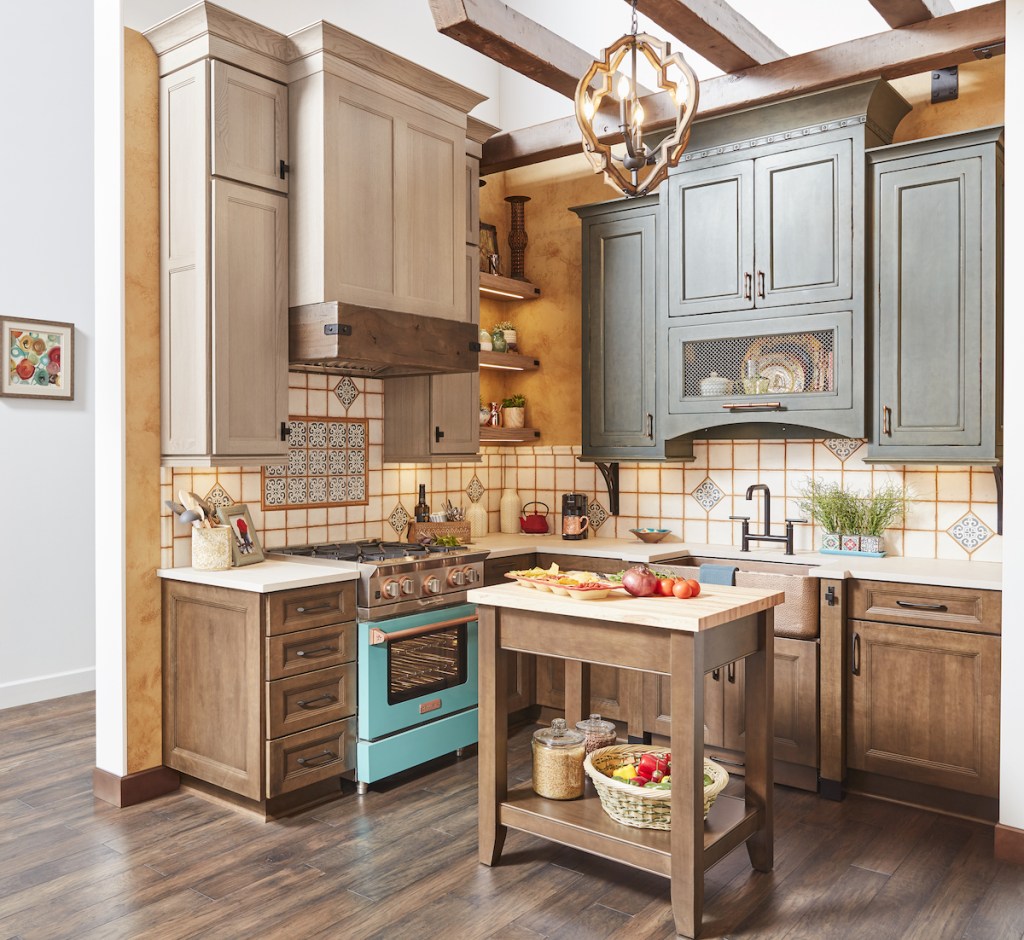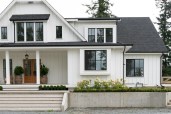On the back of a hot remodeling market, cabinet and countertop sales are expected to remain strong in the near future. Cleveland-based research firm The Freedonia Group estimates cabinet and countertop demand will grow annually about 6% and 2%, respectively, through 2021.
Both market segments are benefiting from the increasing trend of older homeowners who are upgrading their living spaces instead of relocating, and they are particularly interested in updating kitchens and bathrooms, where cabinets and countertops are viewed as important elements. According to Houzz, more than 80% of homeowners upgraded cabinets and countertops when remodeling bathrooms and kitchens in 2018.
Value-added amenities such as pull-out shelving, storage racks, charging ports, and integrated lighting make cabinet updates appealing while the desire for larger kitchens and multiple bathrooms is beneficial to the countertop market.
Clean Looks and Painted Finishes
While both quality and ease-of-living elements are valued in the purchasing of cabinets, both consumers and builders place the highest value on price and aesthetics.
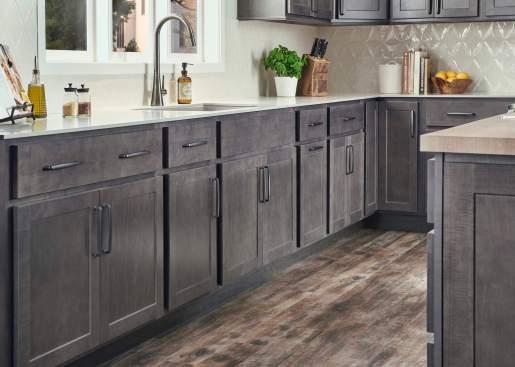
Wolf Home Products features a gray stain option for its Berwyn and Hanover door styles.
“Quality tends to come into play in the top three to five [priorities] once you start to get up in price point,” says Stephanie Pierce, director of design and trends for MasterBrand Cabinets.
Manufacturers are meeting customer demand for products with clean lines. Doors tend to have clean, simple, and elegant designs. Classic door styles, such as Shaker style, remain the most popular option in homes. Houzz reported nearly 60% of renovators elected to install cabinets with Shaker-style door cabinets.
Frameless cabinets are growing in popularity, thanks to interest from millennials, which is forcing companies to offer both framed and frameless options. Warm finishes and colors are trending for frameless cabinetry, says Angela O’Neill, director of marketing and advertising for Wellborn Cabinets. Wellborn’s frameless Aspire cabinetry helps designers meet modern design styles with clean lines and open, spacious interior storage. Despite their popularity, though, frameless cabinets are tougher on remodeling projects for older homes, because they tend to be less forgiving to the imbalances of these homes and the need for adjusting cabinets to imperfect lines.
While a majority of renovators prefer custom and semicustom cabinets, Pierce says MasterBrand is seeing buyers gravitate toward entry-level semicustom cabinets, preferring simple designs with simple profiling and white or gray paint.
White has been the most popular cabinet color since the Great Recession, as homeowners opt for safe, neutral colors with resale in mind. However, cabinets painted in bold colors or in stains that highlight natural wood materials are becoming more popular. As homeowners stay in their homes longer, they are willing to take design risks to create a more personalized space. In addition to beige, kitchen cabinets, in particular, are seeing more bold colors. Blues and greens are among the colors being requested with greater frequency. Gray and two-toned cabinets are becoming more popular, according to the Kitchen Cabinet Manufacturers Association (KCMA).
Maple is becoming a more popular cabinet material as it works well with both painted finishes and stains. Wolf Home Products introduced a gray stain option for its Berwyn and Hanover door styles. MasterBrand launched several mid-to-light wood stains, including Desert in its Omega line of cabinets, to match growing consumer demand.
Innovative Storage in Cabinets
Soft-close cabinets, frameless cabinets, and cabinets with integrated technology are trending upward. The general movement in the cabinet market is toward finding more storage in less space. Wellborn offers an array of spice storage and K-cup storage solutions, as well as options for pot and pan storage via hanging pullouts and wider and deeper drawers. Cabinets with cookie tray organizers, deep drawers, pullout waste and recycling options, and revolving Lazy Susans are the most popular specialty storage options, according to the KCMA.
Mobile device usage is typically high in the kitchen, so cabinets that offer charging ports and storage options are becoming more common in the high-end market. There’s also more interest in LED lighting in the high-end market, but it’s often not installed. Pierce says LED lighting is “usually one of the first things that is sacrificed when budgets start to get tight towards the end of a project.”

Wellborn Cabinets’ Ninka Qanto Lift is a motorized lifting system.
Cabinets with integrated technology are becoming more popular and manufacturers are creating products to meet this demand. MasterBrand introduced its Secured Drawer, featuring biometric technology, in its Diamond Cabinets product line and is increasingly offering motorized cabinets, touch-to-open/push-to-close cabinets, and soft-close cabinets across all of its product lines. Wellborn’s Ninka Qanto is a motion-activated, motorized lifting system that opens with just a movement of the foot.
Material Battle in Countertops
In the countertop market, consumers and builders prefer products that combine durability and style without breaking the bank. A higher premium is also being placed on products that contribute to safe living environments, with anti-slip surfaces in baths and kitchens becoming increasingly popular.
“Today’s homeowner is more attuned than ever to the importance of investing in materials that are built to last,” says Massimo Ballucchi, director of marketing for Cosentino Americas. “While beauty and aesthetics are important, consumers and builders consider durability to be crucial when selecting a countertop material.”
Consumer preferences have begun to shift away from granite, as engineered materials such as quartz are rising in popularity. In the 2019 U.S. Houzz Kitchen Trends Study, quartz was a more popular option than natural stone for kitchen countertops for the first time. According to the study, 48% of renovators opted for quartz countertops, compared to 43% who opted for natural stone countertops. The popularity of quartz has come most directly at the expense of granite, which has seen its market share among renovators decrease 10% since 2017, according to the same report.
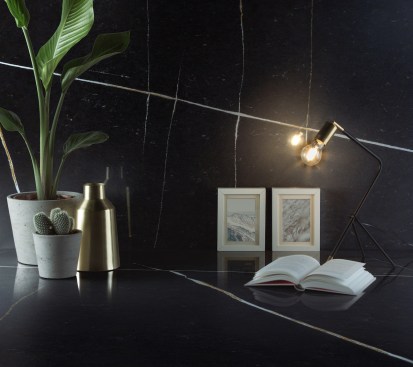
Cosentino’s Silestone is an engineered stone with quartz surfacing.
The Freedonia Group estimates that engineered stone is the fastest-growing market segment for countertops, as the material is more durable and aesthetically pleasing than laminates. Additionally, natural stone such as granite and marble require regular sealing and maintenance, Ballucchi says, while quartz surfacing products are nonporous and require no maintenance. Products such as Silestone by Cosentino offer quartz surfacing with textures that are highly resistant to stains. Quartz surfacing products also offer more extensive color options than natural stone, with products available in whites, blacks, browns, golds, or blues. Technological advances displayed in products such as Cosentino’s Dekton Stonika collection allow engineered stone products to display the “beauty and movement” of natural stone, according to Ballucchi.
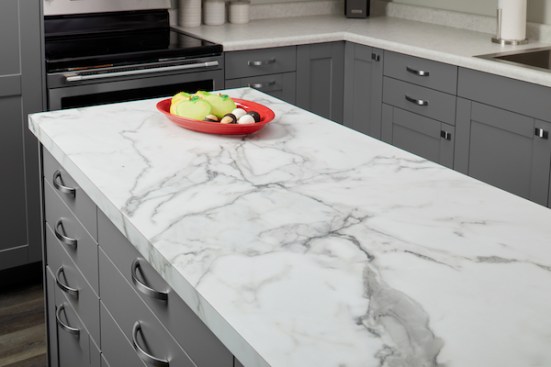
Scott Dorrance
Formica’s 180fx laminates are available in stone and wood-grain styles.
Laminates also remain a viable option because of their cost-effectiveness and minimal maintenance requirements. Manufacturers are diversifying their offerings of specialty and decorative laminates to better compete with other materials. Formica’s 180fx laminates offer high-resolution technology that creates “true-to-scale” patterns of stones and wood grains. Such technology advancements from laminate manufacturers offer homeowners durable, maintenance-free stone and wood-grain styles.
“Today’s laminate has evolved immensely from five years ago due to product developments such as realistic-looking patterns and textures, performance attributes like thermal healing, and new edge options that eliminate the brown line frequently associated with laminate,” says Mike Berg, vice president of sales at Formica Corp.
Additionally, niche materials such as stainless steel, concrete, wood, and recycled materials retain some popularity in the countertop market. Such products offer countertops with high levels of texture. However, the higher price points for wood and metal countertops, in particular, make them less obtainable outside the high-end market.
Nearly one in three upgraded kitchen countertops are white, according to the National Kitchen and Bath Association (NKBA), supplanting multicolored countertops as the most popular color application. Manufacturers are also offering countertops with matte finishes and countertop products with multiple thicknesses and a small range of color options. But the NKBA finds that many designers want bolder color options beyond white and gray and richer colors, as well, suggesting color may be the area of greatest innovation in the short term.
Positive Market Outlook
The main dark cloud for the cabinet and countertop market segments is that both are largely tied to the renovation and new housing markets. While the market for renovations is in the midst of a historic boom, signs suggest the pace could cool in the near future. Additionally, the most recent Leading Indicator of Remodeling Activity (LIRA), from Harvard University’s Joint Center for Housing Studies, is projecting a steep slowdown in remodeling activity by the middle of 2020. Berg says projects involving countertops are likely to be capped due to the labor shortage affecting the construction industry, rather than by decreased demand.
Despite the cautionary tone, many industry organizations are optimistic about the future of the cabinet and countertop market. The NKBA estimates that combined spending for kitchen cabinet and bathroom vanity cabinets reached $28.78 billion in 2017, and it projects kitchen cabinet spending will reach $21.1 billion in 2019 while bathroom vanity spending will increase beyond $10.5 billion. Combined kitchen and bathroom countertop spending, according to the NKBA, is expected to reach over $26 billion by the end of 2019.
